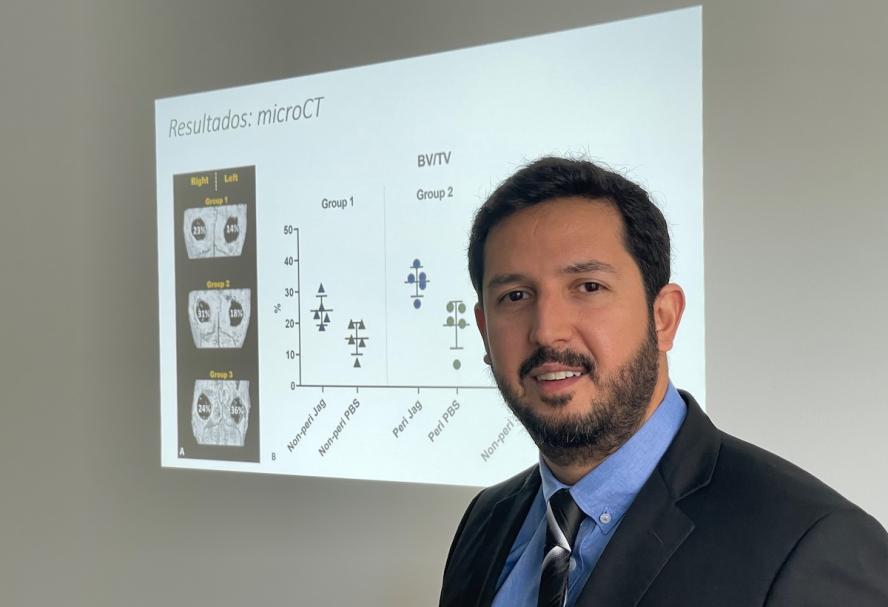-
About
- Leadership & Faculty
- News & Events
-
Academics
- Graduate
- Advanced Clinical Training
- Continuing Education
- Academic Departments
- Academic Offices
- Simulation Experiences
-
Student Life
-
Research
-
Hospitals & Clinics
- Emergency Care
- Hospital Services
-
Community Outreach
- Volunteer
Brazil Native Returns Home for Summer Lecture Tour
Cummings School Professor Rafael Senos, D.V.M., shares experimental orthopedic research

A highly respected researcher in his native country, Rafael Senos, D.V.M. (he/him/his), assistant professor of veterinary anatomy at Cummings School of Veterinary Medicine at Tufts University, returned to Brazil this summer to present results of his experimental orthopedic research, among other topics of his interest and expertise.
In Brazil, Senos developed a scientific research project in collaboration with the Brazilian National Institute for Traumatology and Orthopedics and the University of Michigan. “The project tested the combination of rhJagged-1 (a cell surface protein) with different scaffolds to promote bone regeneration on the calvaria (top of the skull) using the mouse as a preclinical model,” says Senos. “I trained the group and performed all the surgeries of the project, which I self-designed.
“‘Jagged-1’ is a protein that has a cell-to-cell notch signaling mechanism, which in previous in vitro studies indicated the expression of genes related to musculoskeletal cell differentiation, and new bone formation in experiments using preclinical models.”
The project’s next steps, microCT and histological analysis, will be performed in the United States.
In the most recent experiments, Senos has gotten exciting results suggesting Jagged-1 may have potential to repair calvaria gaps in rats and mice, which do not regenerate in normal conditions. The research could have practical applications in the future.
Demographic trends indicate that as the population continues to age, elderly injuries may follow, according to Senos. Studies show that after the age of 50, the risk of fractures are over 50 percent for women and 20 percent for men in the United Kingdom, for example. “In China, approximately 30 percent of older adults fall each year, resulting in fractures in more than 85 percent of those cases. Among head injuries, 35 percent of the elderly population have had a skull fracture, in which 43 percent was a calvarial fracture,” he says.
“In addition to calvarial fractures, segmental skull defects may also result from surgical procedures such as decompressive craniotomy or craniectomy—permanent surgical removal of part of the skull—in patients that had increased intracranial pressure due to different reasons such as a stroke.”
According to Senos, covering this gap requires use of either a bone graft (which has around 50 percent bone resorption and is not viable in most cases) or a titanium plate, which either becomes infected or the body rejects it about 45 percent of the time. Jagged-1 may be an alternative approach, as it promotes bone regeneration, but has limitations.
"My latest study, which is under review before it is sent to publication, reveals that I can now produce 35 percent of bone regeneration, in comparison to 16 percent regeneration in the control group in preclinical models," he says. “It is far more than I was expecting."
“To optimize the outcomes of the Jagged-1 in the calvaria regeneration, we are experimenting with the association with different scaffolds, biomaterials of a different nature. The actual experiment will be concluded in the next six months.”
Before coming to the United States in 2016, Senos had become well-known in Brazil for teaching a course on the anatomy of the rat. After emigrating, and working on research projects at Michigan State, University of Michigan, and Johns Hopkins University, he received several requests from institutions in Brazil to guest lecture.
“I feel that I owe a lot to Brazil, as my Brazilian people paid for my formal education through taxes. Whenever I have the chance, I retribute to my country through scientific cooperation,” Senos acknowledges. He holds a D.V.M. from Universidade Federal Fluminense, and both a MSc and DSc from Universidade de São Paulo.
During the summer, Senos made five in-person and three online presentations overall at the Brazilian National Institute of Traumatology and Orthopaedics, Federal University of Ceará, Federal University of Rio de Janeiro, Fundação Oswaldo Cruz (Fiocruz), Rio de Janeiro State University, and Universidade Federal Fluminense.
According to Senos, Fiocruz is the most important institute for tropical disease and epidemiology research in the Southern Hemisphere. At some institutions the attendance exceeded the capacity of the venues in which he presented.
With experience and expertise in several areas, Senos tailored his presentations to fulfill the request of each institution’s host and audience. Topics ranges from Jagged-1 in bone regeneration to animal welfare in research using rodents, to the anatomy of the rat applied to research, to academic career development.
Senos developed a keen interest for animal welfare after participating in a contest for large animal welfare studies as a D.V.M. student in Brazil. “Later, when I became a doctor of laboratory animals, I focused on animal welfare for three years,” he explains. “I realized that people may not always use animals the right way in research, so I tried to educate young researchers while improving laboratory animal practices. I explained general concepts, the consequences of bad habits, and proper anesthesia techniques, for example.”
Senos is eager to continue his research, learning and sharing his knowledge with students and colleagues. He professes, “I am enthusiastic for those different scientific activities, and I feel like I am giving my small contribution to science.”
Department:
Dept. of Comparative Pathobiology